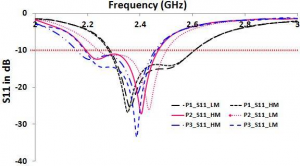Design of Textile based Microstrip Antennas for Body Area Network (BAN) at 2.4 GHz ISM band
Pema Choki1, Ratna Bdr. Ghalley2, Yonten Zangpo3, Purna B. Samal4
Departnment of Electronics and Communication, College of Science and Technology.
* E-mail: 12010079@cst.edu.bt,22009071@cst.edu.bt, 32010156@cst.edu.bt,4purna@cst.edu.bt
Abstract
The design of three different textile base microstrip antennas at 2.4GHz ISM band for the application in Body Area Network (BAN) is proposed. The proposed antennas are evaluated both in free space and on body environment presenting the performance characteristics through important antenna parameters. The use of the same design material and full ground plane are some of the common properties among them. The proposed antenna operates in the closed proximity of a human body which provides directional radiation pattern with a minimum back radiation. The risk of coupling with the human body is reduced by the use of full ground plane. Moreover the full ground plane also exhibits the important property of preserving the performance when placed in on body environment. The study of fidelity are also provided.
Key Words : Industrial, Scientifics and Medical (ISM), Body Area Network (BAN), Microstrip antenna, Textile antennas, Antenna Fidelity.
1. INTRODUCTION
The advancement of wireless communication spread has conquered the larges distance of time and space making our life easier and comfortable. The wireless communication system comprises of electronic devices, antennas and sensors of various shapes and sizes of which microstrip (patch) antenna is one of them. Flexible textile based Microstrip antennas are one of the most attractive antennas that provide wearable application as they can be integrated into clothing and have low-profile, light weight and portable feature. Generally it consists of dielectric substrate sandwich between radiating patch on upper side and ground plane on the lower side.
Textile base microstrip antenna is modelled to operate at 2.4 GHz using CST studio Microwave for ISM band with permissible operating bandwidth, gain, efficiency and radiation patterns. These parameters are evaluated both in free space and on body environment. The performance of the proposed microstrip antennas provides the minimum back radiation as antennas are facilitated with with full ground plane. The on body application requires body area network (BAN) for communication within and around the body. These types of antenna can be used in medical monitoring and sensing, military, sport and consumer electronics.
2. TOOLS AND MATERIALS USED
The ShieldIt Super is used as conductor for ground plane and radiating patch (radiator) and it is coated with Nickel and Copper for perfect shielding and low corrosion (EMF Shielding and Conductive Fabrics). ShieldIt Supper from LessEMF Inc. has the conductivity of 1.18×105 S/m and the thickness is 0.17mm that can withstand temperature up to 250oC. Felt material is used as substrate in this project having 3mm thickness with a relative permittivity of 1.45 and a loss tangent tan of ± 0.044 is used. A 50 Ω SMA connector model 546-3181 is used to feed the antenna from ground to patch adapting the co-axial feed technique (Samal, Soh, & Vandenbosch, 2013).
Different tools like pencil, knife, scales, iron and Caddo Soldering are used in fabrication of antennas.
3. ANTENNA DESIGN
The antennas are theoritically designed to resonate at 2.4GHz. Taking the theoretical parameters as initial input, the optimization is performed through simulations. Computer Simulation Technology (CST) Studio in transient domain environment is used for the simulation and optimization of the design.
The criteria taken into account for optimization are as follows:
- Small antenna size.
- Bandwidth measured at -10dB.
- Resonating frequency at 2.4 GHz.
- Reduced complexity in antenna topology.
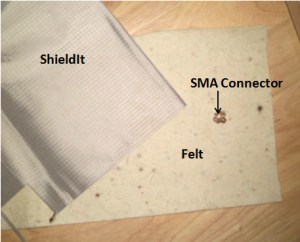
Fig 1 Textile materials and SMA Connector
4. RESULTS AND EVALUATONS
In this section the simulated results of the antenna parameters are presented. The important antenna parameters are reflection coefficient (S11), gain, efficiency and radiation pattern where the radiation patterns are observed in far field time domain because in the these region the pattern is well formed, usually consisting of few minor lobes and one or more major lobes (Balanis, 2005).
The Figure 3 shows the FS simulated results of the three final prototypes in both high mesh(HM) as well as low mesh (LM) settings. The legend at the right bottom corner shows the S11 of three different prototypes in LM and HM. Prototype 3 yeilds the largest bandwidth of 400 MHz in LM and Prototype 1 with 330 MHz in HM. The difference in their bandwidth is due to increased accuracy in HM setting.
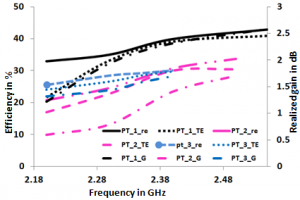
Fig 3 Simulated FS gain and efficiency
The simulated high mesh efficiency and realized gain for free space is provided in Fig 3, showing variation in efficiency and gain with changes in the frequencies within the range of 2.18 GHz to 2.58 GHz. The legend shows the realized gain (G) in decibel, radiation efficiency (re) and total efficiency (TE) in percentage of three different modelled antennas.The efficiency includes total and radiation efficiency. All the three prototypes simulated results are indicated in a graph. The efficiency is within the range of 10 to 40 %, while realized gain is between 0.5 to 2.7dB approximately. The prototype 1 obtains the highest gain of 2.3 dB at 2.4 GHz.
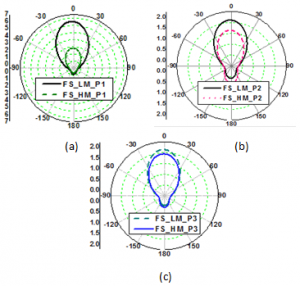
Fig 4 FS radiation pattern in YZ plane for (a) Prototype 1, (b) Prototype 2, (c) Prototype 3
This radiation pattern shows that the antenna radiates more power in a certain direction than another direction. The antenna is said to have certain directivity which is commonly expressed in dB. The designed model here described is a perfect front to back ratio making all radiation towards the front and no radiation towards the back with 2D polar plot.
4.2 On-Body
To evaluate the antenna performance in proximity of a human body, a homogeneous body model is used. It is placed under the structure with an air gap of 10mm. It has a relative permittivity of 50.8 and its conductivity is 3 S/m . This air gap emulates a realistic approximation of the actual placement of the antenna on the human body with clothing
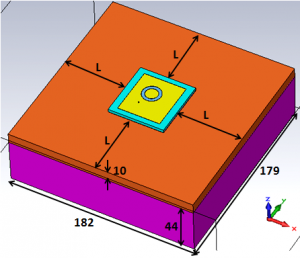
Fig 5 Dimensions of the homogeneous body model (L=62.5mm)
The first prototype has a bandwidth of 297MHz in LM settings and maximum bandwidth of 300MHz in HM setting. The second prototype has a bandwidth of 270MHz in LM settings and 290MHz in HM. Similarly, the third prototype has a bandwidth of 146 MHz in LM and minimum of 151 MHz bandwidth in HM.
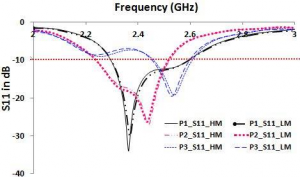
Fig 6 Simulated OB S11 results
The simulated results for all the prototypes are included in a graph with the variation in efficiency and gain with change in frequencies ranging from 2.18 GHz to 2.58 GHz. The maximum gain is obtained by prototype one, which is near to 1.8 dB at 2.58 GHz. The efficiency is obtained within the range of 10 to 40 percentages covering three prototypes’ efficiency in high mesh setting. Individually there efficiencies are deviated from each other by maximum up to 10% and down to 2% at 2.4 GHz. Realized gain is obtained between 0.5 to 1.8 dB approximately.
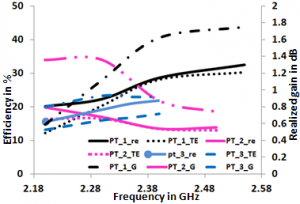
Fig 7 Simulated OB gain and efficiency
The OB performances of the overall antennas brings the variation in the results with distorted radiation patterns. For higest possible degree of accuracy in the results, the modelled is operated in HM apart from LM. The comparison of radiation pattern simulated in OB with low mesh and high mesh setting are shown in Figure 8.
The deviation in magnitude of the main lobe can be observed.
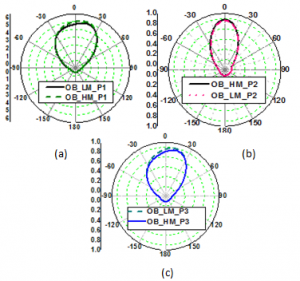
Fig 8 OB radiation pattern in YZ plane for (a)Prototype 1, (b)Prototype 2, (c) Prototype 3
The distortion of the radiation patterns are represented in three dimension where the magnitude of main lobe is deviated by some angle. Moreover, the distortion can easily be observable with asymmetric in the radiation patterns. This is due to the coupling between the human skin and muscles producing the loss in the power.
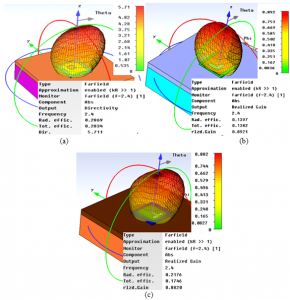
Fig 9 OB 3D radiation pattern
5. FABRICATION
The full ground plane is design and simulation to avoid back radiation and the dimensions of design antennas are taken as small as possible. The patch and ground plane of the antenna are cut using cutters and scissors maintaining the accuracy as far as possible. The substrate is sandwich between two radiators such that there is no air gap between the conducting materials with the help of ironing machine. A snapshot of the fabricated antennas is shown in the Fig 10.
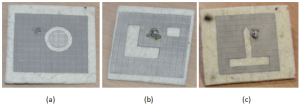
Fig 10 Fabricated antennas (a)Prototype 1, (b) Prototype 2, (c)Prototype 3
6. FIDELITY
The antenna performance evalution is done using CST studio Microwave. This evaluation of the fidelity provides close to the practical information how the designed antenna performs in receiving the field signals in spherical coordinates in various planes.The actual meaning of fidelity (F) is the maximum correlation coefficient of the two signals by varying the time delay (Joardar & A., 2006). The fidelity is computed by determining the absolute max or peak value of the cross-correlation function of the signals (Dumoulin, Ammann, & McEvoy, 2009). This was done using the default Gaussian pulse and the template based post processing in CST MWS.
The FS and OB evaluation is computed by placing probe in spherical coordinate system in theta and phi orientation. Probes were placed at every 45° at 100 cm for FS from the antenna. The position of probes placed by varying either theta or phi and keeping either of them constant.
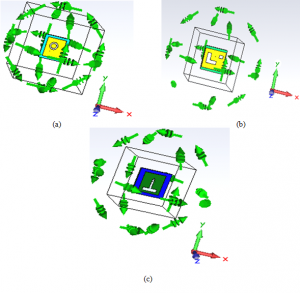
Fig 11 FS probe placement in three different planes for (a) Prototype 1, (b) Prototype 2, (c) Prototype 3
The FS performance evalution of the antennas is done in different orientation placing in various position. The performance results is provided with the two dimensions plot. The maximum fidelity factor obtained are 94.3% at 315o in phi orientation (theta=90, varying phi) by ptototype 1, with 97.5% at 135o in theta orientation (phi=90o, varying theta)by prototype 2 and 97.6% at 90o in Phi orientation (theta=90o, varying phi) for prototype 3.
6.1 On-Body
On body fidelity test probes were placed at every 45° but at 150 cm since the probes are overlapping the design antenna at 100 cm. Fig 13 presents the position of probes placed by varying either theta or phi and keeping either of them constant.Similarly the OB measurements is performed considering antenna as a receiver.The maximum fidelity obtained by prototype 1 is 91.3% at 180o in phi orientation (theta=90o, varying phi, then prototype 2 with 96.7% at 90o in theta orientation (theta=90o, varying phi), and 96.3% at 135o in theta orientation (theta=90o, varying phi) for prototype 3.
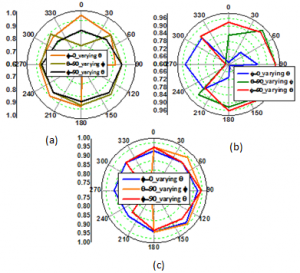
Fig 12 FS simulated fidelity in three different planes for (a) Prototype 1, (b) Prototype 2, (c) Prototype 3.
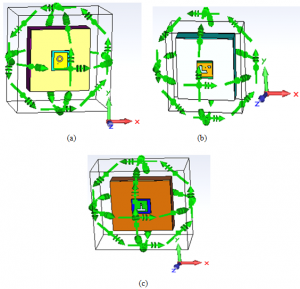
Fig 13 OB probe placement in three different planes for (a) Prototype 1, (b) Prototype 2, (c) Prototype 3
7. CONCLUSION AND FUTURE SCOPE
The initial designs started from a very simple basic structure with the plane patch. Then the slot is introduced to increase the bandwidth. To obtain the required bandwidth below -10 dB, the areas of slot is improved and simultaneously reducing the overall size of antenna. All the proposed antennas operated in 2.4 GHz within the bandwidth ranges of 2 to 3 GHz.
Moreover, the comparison evaluation is also performed between FS and OB environment interms of reflection coefficient, gain efficiencies and radiation pattern.The ATA-FGP of the antenna prove to preserve its S11 performance when it is place on body showing that there is less back radiation in all three antennas.
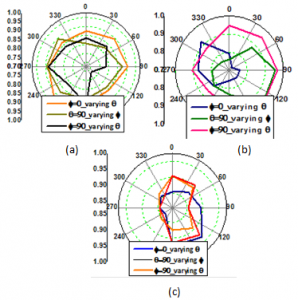
Fig 14 OB simulated fidelity in three different planes for (a) Prototype 1, (b) Prototype 2, (c) Prototype 3
The fidelity factor of each antenna in FS is found to be better than OB.
- To reduce complex design for higer bandwidth, one could double the thickness of substrate. But the designer should not forget with the increase of the substrate height the size and conformity of the antenna reduces.
Complexity during fabrication increases when the design prototypes are small and complex. Here complex in design can refer to the minimum gap used between circular parasitic radiator and main radiator in case of prototype 1. Since the textile has to be cut using manual cutting tools like scissor and knife a gap of 1mm cannot be maintained evenly and also to maintain this gap between circular parasitic radiation and main radiator is a work of the professional.
- Solution could be utilizing high precision tools other than manual cutting tools.
- Although the simulated results are more definite due to almost zero human error, the fabricated antennas must be measured to study the degree of error that occurs due to manual fabrication of the antennas.
- The effect of bending the antennas also needs to be studied to understand the characteristics of the antenna when placed on the body. Since the body movement will obviously change the orientations of operating antenna plane.
- The overall gain achieved for the three prototypes are low. To increase the gain for higher application the proposed antennas could be done with lower permittivity substrate. Or else if the size is not a serious concern, it could be increased which will further increase the gain.
8. REFERENCE
Akhoondzadeh, L., Fardis, M., Abolghasemi, A., & Dadashzadeh, G. (2008). Frequency and Time Domain Charateritics . 340-343.
Balanis, C. A. (2005). Antenna Theory: Analysis and Design. Canada: Jhon Wiley & Sons.
Dumoulin, A., Ammann, M. J., & McEvoy, P. (2009). Performance Evaluation of Antennas for UWB Radar and Poitioning System., (pp. 1-6).
EMF Shielding and Conductive Fabrics. (n.d.). Retrieved from LessEMF.com
Joardar, S., & A., B. B. (2006). Two new ultrawideband dual polarized antenna-feeds using planar log periodic and innnovative frequency independent reflector. J. of Electromagn. Waves and Appl, 1465-1479.
Samal, P. B., Soh, P. J., & Vandenbosch, G. A. (2013). A Systematic Design Procedure for Microstrip-Based Unidirectional UWB Antennas. Progress in Electromagnetics Research, 26.
Samal, P. B., Soh, P. J., & Vandenbosch, G. A. (2013). UWB All-Textile Antenna with Full Ground Plane for Off-Body WBAN Communcations. IEEE Transactions on Antennas and Propagation, 8.

